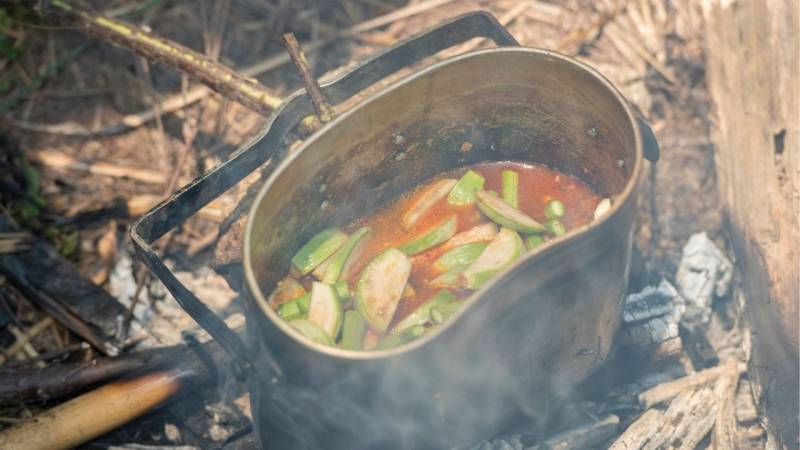
steam food
Nomen
Meaning
Steam food is a cooking method commonly used in outdoor settings such as survival, bushcraft, and camping. It involves using steam to cook food, typically by placing it in a container or wrapping it in leaves and placing it over a heat source. This technique is popular because it allows for healthy and flavorful meals without the need for pots, pans, or excessive fuel. Steam food is especially relevant in the outdoor community as it provides a convenient way to prepare meals using minimal resources. It is a versatile and efficient cooking method that can be used to cook a variety of foods in the wilderness.

Examples
„I love using steam to cook my food when I'm out in the wilderness. It's a great way to prepare a delicious and healthy meal without needing a stove or fire.“
„Steam food is a popular technique among survivalists and bushcraft enthusiasts. It allows you to retain the nutrients and flavors of the ingredients while using minimal resources.“
„When I'm camping, I often steam food by wrapping it in foil and placing it over a pot of boiling water. It's a simple and effective method that requires little effort.“
„One of my favorite steam food recipes is steamed fish with herbs and vegetables. The steam gently cooks the fish, keeping it moist and tender, while infusing it with the flavors of the herbs and vegetables.“
„Steam food is not only delicious, but it's also a healthy cooking method. By steaming your food, you can avoid using oils or fats, making it a great option for those watching their calorie intake.“
Origin
The word "steam food" originates from the English language. It is a combination of the verb "steam," which means to cook food using steam, and the noun "food," which refers to any substance consumed to provide nutritional support.
The practice of steaming food has its roots in ancient cooking techniques. Steaming has been used for centuries in various cultures around the world, including China, India, and the Middle East. It is a gentle and healthy method of cooking that helps retain the natural flavors, nutrients, and textures of the ingredients.
Over time, the concept of steaming food has evolved, and today it is widely recognized as a popular cooking method in many cuisines. Steamed dishes can range from simple vegetables and seafood to more complex recipes like dumplings and buns.
In recent years, the popularity of steam food has grown due to its health benefits and the increasing interest in natural and nutritious cooking methods. Steaming is often preferred over other cooking techniques as it requires minimal oil and preserves the integrity of the ingredients.
Whether you are a professional chef or a home cook, steaming food is a versatile and convenient way to prepare delicious and healthy meals. It allows you to explore a wide range of flavors and experiment with different ingredients while maintaining their nutritional value.
Synonyms
Steamed food, Steamed meals, Steamed delicacies, Steamed fare, Steamed dishes, Steamed cuisine
Antonyms
Frozen food, Raw food, Uncooked food, Chilled food, Cold food, Fresh food, Unheated food, Unprocessed food
Relatives
Cooking, Steaming, Food preparation, Healthy eating, Culinary technique, Kitchen appliances, Nutrition, Cooking methods
Historical and cultural importance
Steam food has a long history and cultural significance in many different cuisines around the world. It is a cooking method that involves using steam to cook food, typically in a covered pot or steamer basket. This technique has been used for centuries and is still widely practiced today.
In Chinese cuisine, steaming is a traditional and essential cooking method. It is believed to preserve the natural flavors and nutrients of the ingredients, resulting in healthier and more flavorful dishes. Dim sum, a popular Chinese cuisine, often includes a variety of steamed dumplings and buns.
In Thai cuisine, steaming is also commonly used, especially for dishes like steamed fish with lime and chili sauce. This method allows the fish to retain its moisture and delicate texture while infusing it with the flavors of the sauce.
Steam food is also prevalent in other Asian cuisines, such as Japanese and Korean. In Japanese cuisine, steamed rice, known as "gohan," is a staple dish. It is often served alongside various steamed vegetables and seafood. In Korean cuisine, steamed dishes like "jjim" (steamed meat or fish) and "jjinppang" (steamed buns) are popular.
Furthermore, steaming is not limited to Asian cuisines. In Mediterranean cuisine, steamed vegetables, such as artichokes and asparagus, are commonly enjoyed. In South American cuisine, tamales, a traditional dish made of masa dough filled with various ingredients, are often steamed.
Overall, steam food has a rich historical and cultural significance in various cuisines worldwide. It is a cooking technique that allows for the creation of flavorful and nutritious dishes, making it a valuable skill for any aspiring cook or food enthusiast.
More information about the term steam food
What is Steam Food?
Steam food is a cooking method that involves using steam to cook food. It is a healthy and nutritious way of preparing meals, as it retains the natural flavors, colors, and nutrients of the ingredients. This cooking technique has been used for centuries and is popular in many cultures around the world.
How Does Steam Food Work?
When you steam food, you place it in a steamer basket or a steaming apparatus above boiling water. The steam generated from the boiling water cooks the food gently and evenly. The hot steam surrounds the food, creating a moist environment that helps to preserve its natural moisture and prevent it from drying out.
Unlike other cooking methods that require the use of oil or fat, steaming doesn't add any extra calories or unhealthy fats to your food. It is a great option for those who are watching their weight or trying to maintain a healthy diet.
Benefits of Steam Food
There are several benefits to cooking food using steam:
1. Retains Nutrients: Steaming helps to retain the vitamins, minerals, and antioxidants present in the food. Since the food is not submerged in water, the nutrients are not leached out during the cooking process.
2. Preserves Natural Flavors: Steaming allows the natural flavors of the ingredients to shine through. It enhances the taste of vegetables, seafood, and meats without overpowering them with added seasonings or oils.
3. Maintains Texture: Steaming helps to maintain the texture of the food, especially vegetables. They remain crisp and vibrant, making them more visually appealing and enjoyable to eat.
4. Low in Calories: Since no additional fats or oils are used in steaming, it is a low-calorie cooking method. It is a great option for those who are trying to lose weight or maintain a healthy lifestyle.
Types of Food That Can Be Steamed
Almost any type of food can be steamed, including:
- Vegetables: Broccoli, carrots, cauliflower, asparagus, and more.
- Seafood: Fish, shrimp, mussels, and crab.
- Poultry: Chicken, turkey, and duck.
- Rice and grains: Jasmine rice, quinoa, and couscous.
- Dumplings: Steamed buns, potstickers, and dim sum.
Conclusion
Steaming food is a healthy and versatile cooking method that allows you to enjoy the natural flavors and nutrients of your ingredients. It is a great option for those who want to maintain a healthy diet without compromising on taste. So, next time you're in the kitchen, give steaming a try and discover the delicious and nutritious meals you can create!
Back to overview

